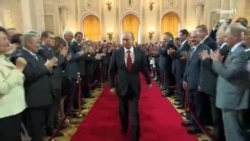A team of European neurologists says in a new study that Russian President Vladimir Putin walks with a peculiar "gunslinger's gait" -- a reduced swing in his right arm -- possibly related to weapons training he received in the Soviet KGB.
The study, published December 14 by the weekly peer-reviewed British medical journal The BMJ, notes that Putin has shown in public appearances a "clearly reduced right-sided arm swing," the type of asymmetrical arm movement that can be an early sign of Parkinson’s disease.
But the authors -- researchers based in Portugal, Italy, and the Netherlands -- say that Putin has displayed no other tell-tale signs of the disease.
In fact, they write, he shows "excellent motor skills" as evidenced by video footage of him enjoying athletic activities like judo and swimming -- a key component of his public image that has long been fodder for fawning Russian state media coverage -- and signing official documents.
Citing a KGB training manual they obtained, the researchers posit that his style of walking is instead linked to training that Putin underwent in the feared security agency, where he rose to the rank of lieutenant colonel before retiring at the twilight of the Soviet Union.
"According to this manual, KGB operatives were instructed to keep their weapon in their right hand close to their chest and to move forward with one side, usually the left, presumably allowing subjects to draw the gun as quickly as possible when confronted with a foe," they write.
To test their hypothesis, the neurologists studied YouTube videos of other Russian officials.
Bastiaan Bloem, a professor of movement disorder neurology at Radboud University Medical Centre in Nijmegen, the Netherlands, who led the study, said his team was "stunned" by what they saw.
They found the same characteristic walk in Prime Minister Dmitry Medvedev, in former Russian defense minister Anatoly Serdyukov and Sergei Ivanov, and in senior Russian military commander Anatoly Sidorov.
Like Putin, Ivanov is a former KGB officer who served in Europe during the Cold War. Serdyukov and Sidorov both received military training, the researchers note.
The outlier in this group is Medvedev, a lawyer by training who has no clear ties to the KGB and did not serve in the military, though he underwent brief reservist training during his university years.
Since Putin handpicked him to serve as president from 2008-12 -- between Putin’s second and third terms -- Medvedev's body language has often resembled that of his mentor, as has the cadence of his speech.
Citing Western media reports, the researchers write that "substantial evidence suggests that Medvedev is being coached to sound, look, and importantly, walk like the president."
The study asserts that Putin's asymmetrical arm swing is likely "a behavioral adaptation resulting from military or intelligence training."
Bloem told AFP that the Russian leader's reduced arm swing could "in part be overlearned."
"It's like saying, 'Look, folks, I've had KGB training, I'm a real man,'" he said.
Bloem conceded that researchers do not have access to Putin's medical records or his doctors. But he said Putin's unusual walk is the subject of a small but growing debate among medical specialists.
"It is an unusual study, but there is a very serious message to it" about neurological observation, he told AFP in a telephone interview.
Bloem added that Putin's "abnormal gait has been noted before."
"What we are putting forward, but very cautiously, is a new hypothesis," he said.









